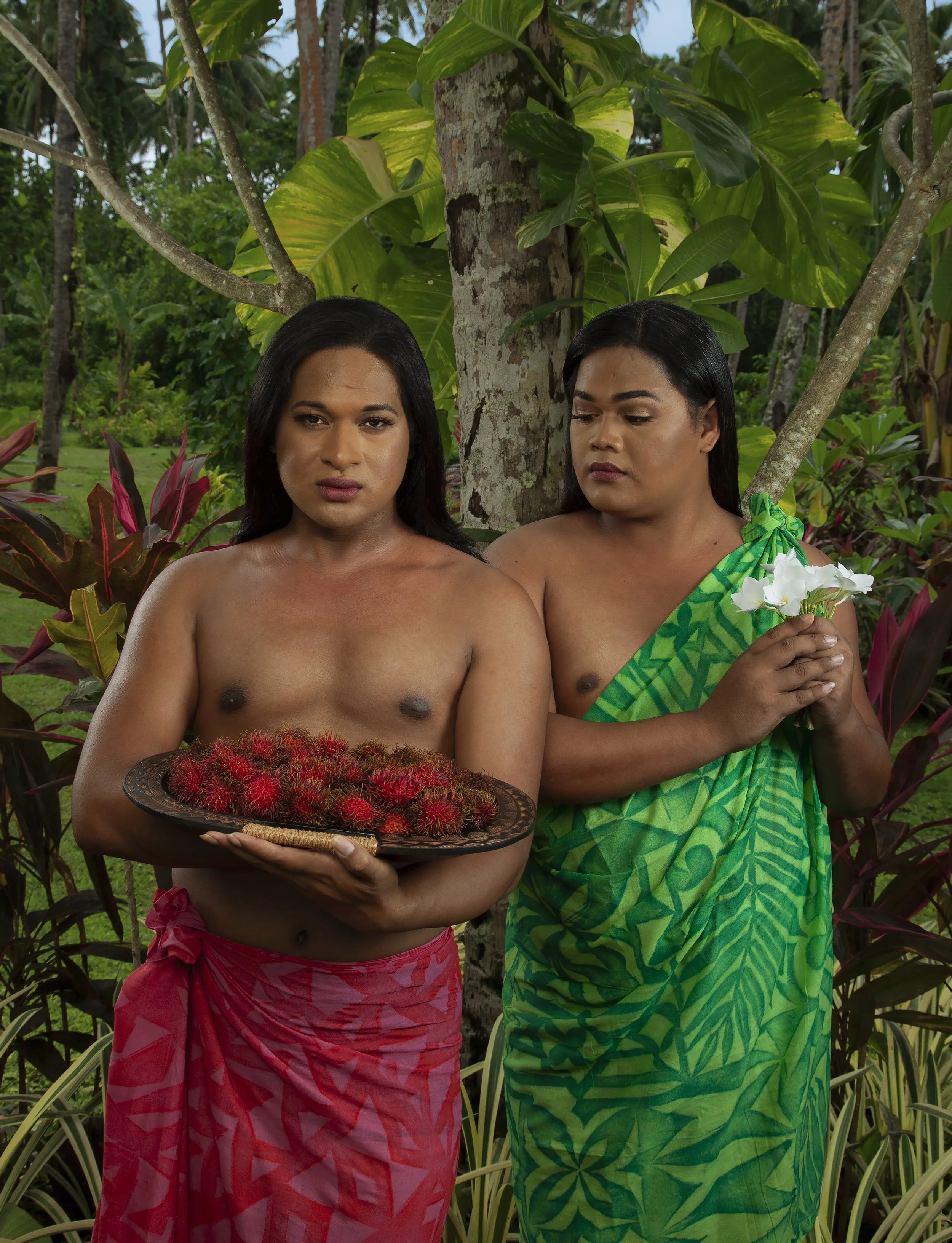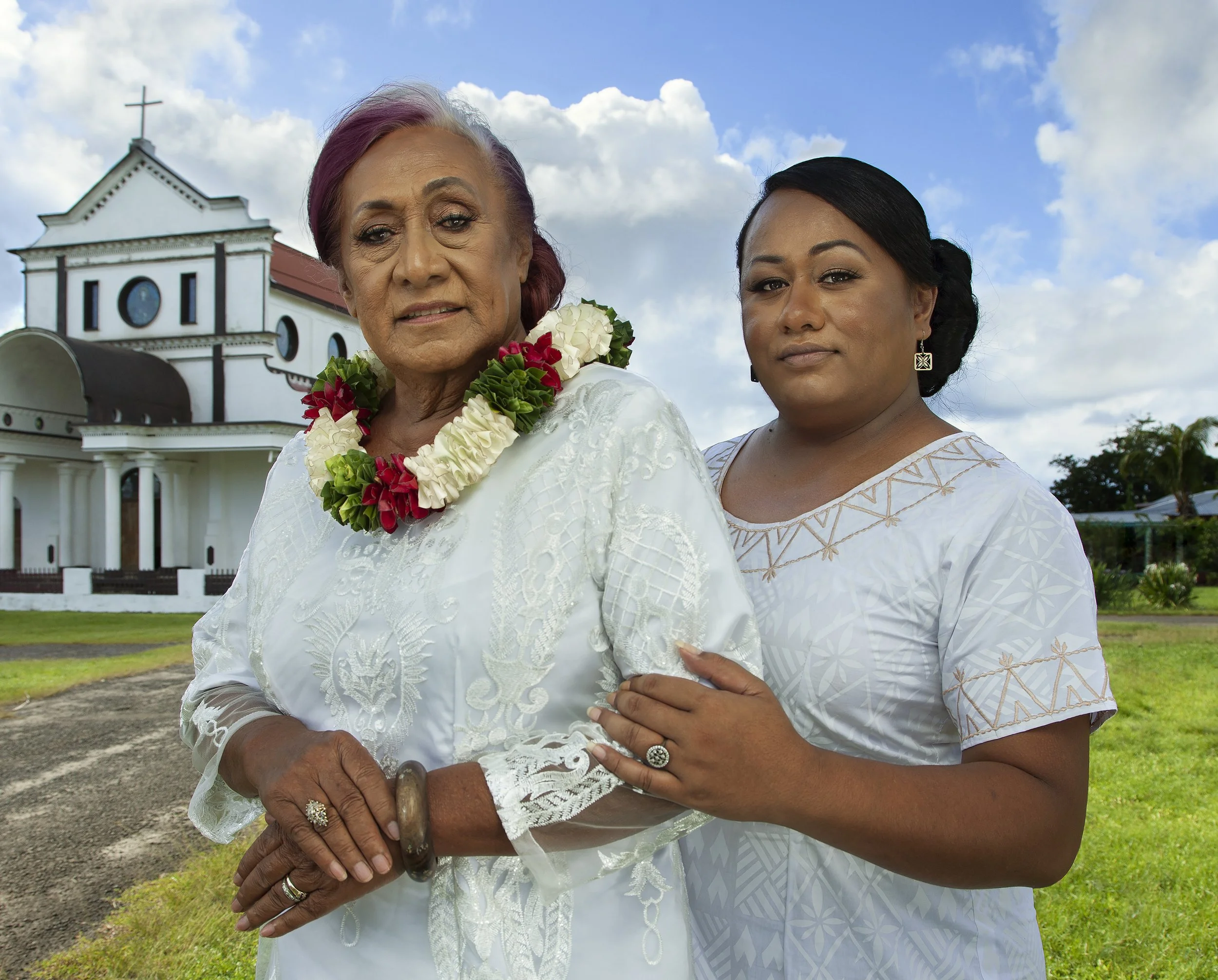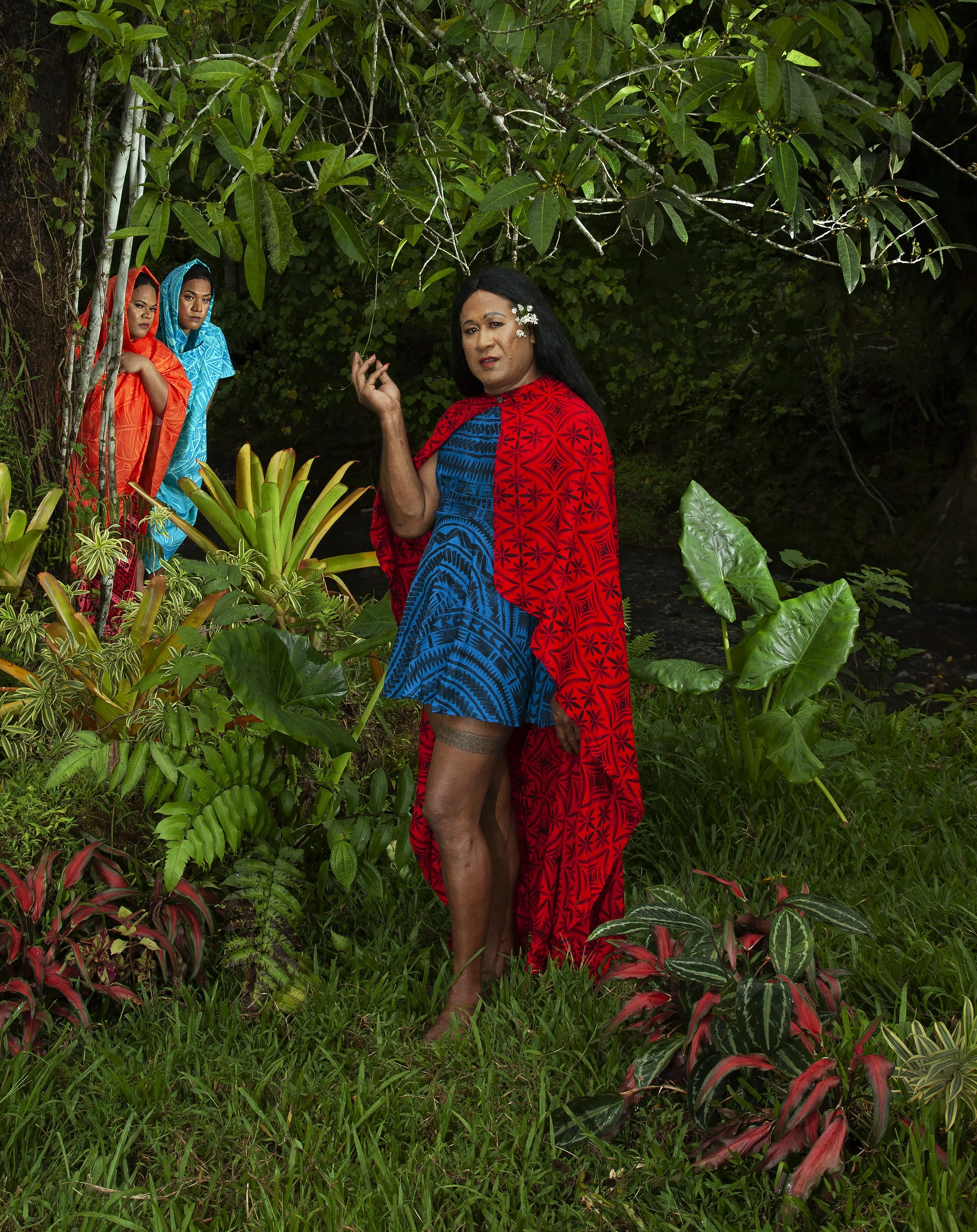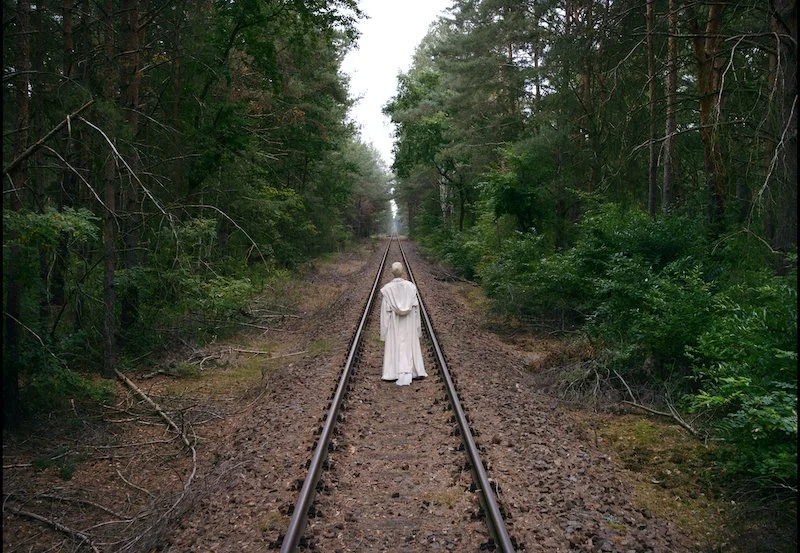Book Review: Paradise Camp
Si‘ou alofa Maria: Hail Mary (After Gauguin), 2020. Hahnemühle fine art paper mounted on aluminium 87.6 × 113.7 cm © Yuki Kihara
In Sāmoa, it is often said that "the most beautiful women are men." (Paul Miles, Transgender in the Pacific - Fa'afafine, fakaleiti and mahu.)
As with all Polynesian countries, cross-dressing has been an important aspect of Sāmoan culture and is inseparable from their history. In 1789, during a stay on the island of Tahiti, then known as Otehetie, marine officer George Mortimer wrote in his journal of an encounter between one of his fellow sailors and a local girl at a night-time dance, whom he was “very much smitten with.” Upon inviting her to return to the ship with him after the performance had ended, the sailor was surprised to learn that “this supposed damsel, when stripped of her theatrical paraphernalia, a smart dapper lad.” (Observations and remarks made during a voyage. London 1791.)
Si‘ou alofa Maria: Hail Mary (After Gauguin), 2020. Hahnemühle fine art paper mounted on aluminium 87.6 × 113.7 cm © Yuki Kihara
Mortimer’s diary entry was one of the earliest Western references to the presence of a third gender in French Polynesia. For centuries, the cross-dressers in the Sāmoan islands have baffled and intrigued Western missionaries and colonial settlers. Even today, as tourists continue to visit the islands to watch the famous Polynesian dancers in their hotels or at nightclubs, western understanding of the gender-liminal individuals of the Sāmoan community is still limited. Western discourses have often mistakenly used equivalent terms in the English language to categorize these Sāmoan cross-dressers, incorrectly referring to them as gay, transvestite, transexual, or simply as "drag queens,” which members of the Sāmoa society state are a result of acculturation. On page 19 of Paradise Camp, Resitara Apa explains, “We are not drag queens, or female impersonators trying to impersonate somebody, no. We are who we are.”
Two Fa‘afafine (After Gauguin), 2020. Hahnemühle fine art paper mounted on aluminium 94 × 72 cm © Yuki Kihara
Rupturing into this conversation surrounding Polynesian gender identity is Sāmoan-Japanese interdisciplinary artist Yuki Kihara, who identifies as Fa'afafine, Sāmoa's third gender community, which translates to 'in the manner of a woman.” Kihara’s perspective carries the same astuteness and matter-of-fact tone that Apa’s statement holds: with unflinching flair and humor, her photographs repurpose paintings by Paul Gauguin, created during his time in the islands of Tahiti and the Marquesas between 1891 and 1903. Taking issue with Gauguin’s Eurocentric depiction and exoticizing of Indigenous peoples, Kihara poignantly uses upcycling as a tactic to defiantly disrupt the colonial bias and its problematic gaze. By amplifying the distortions in Gauguin’s skewed illustration of Māhū, Paradise Camp cleverly satirizes the Orientalism purported by Western colonial powers and reinstates Indigenous queer histories from a counter perspective.
Three Fa‘afafine (After Gauguin), 2020. Hahnemühle fine art paper mounted on aluminium 73 × 94 cm © Yuki Kihara
The book’s eighth chapter, eponymously titled Paradise Camp, presents the reader with twelve tableau photographs featuring a cast of Sāmoan Fa'afafine alongside Gauguin’s original paintings. The liminal “paradise” suggested in Gauguin’s landscapes and their murky backgrounds get transported in Kihara’s vision, onto locations that actually show the flora and fauna of the land.
Two Fa‘afafine on the beach (After Gauguin), 2020. Hahnemühle fine art paper mounted on aluminium 69 × 91 cm © Yuki Kihara
In her take on the painting Ta Matete, titled Genesis 9:16 (After Gauguin), a group of models is seated across a bench in the manicured gardens of a local resort wearing traditional textiles. Significantly, the group is assembled so that their colorful outfits are in the order of the rainbow; a deliberate staging that nods to Kihara’s title choice for the photograph, a biblical passage from Genesis that describes the rainbow as “the symbol of the sacred covenant between the divine and all living things on earth” (page 27). By supplying this context, the rainbow in the photograph becomes more than simply alluding to the gay pride movement and Western rainbow pride, as it takes on this new meaning as the symbol for the portal between the mortal and divine world, which pertinently speaks to the condition of the Sāmoan population living on an archipelago.
Genesis 9:16 (After Gauguin), 2020. Hahnemühle fine art paper mounted on aluminium 73.2 × 91.5 cm © Yuki Kihara
Less concerned with realism, Gauguin’s style was of the early modernist pursuit for formal reduction: his wide brush strokes were to convey the simplicity of the “primitive” Polynesian, as existences that are blended onto the blurred landscape. Departing from using abstraction as an aesthetic, Kihara’s high-resolution photography offers piercing clarity to the things that were masked and unseen in Gauguin’s paintings. The intensely bright color scheme brought out by the high-quality resolution in Kihara’s photographs has the same lack of verisimilitude as Gauguin’s works, but whereas the paintings invite the eye to indulge in the sensuousness of the colors, Kihara’s photograph’s use of overstated colors plainly demonstrate how the otherness of the Sāmoan landscape is resultant of tourism and Western consumption. The Sāmoan models in Genesis 9:16 (After Gauguin) are shown with flowers in their hair, holding Irubuli (Fijian hand fans) and conch shells; the obvious staged-ness mixed with the use of props creates an altogether new iconography that challenges the colonialist notion of ‘paradise.”
In the book, Kihara explains, “The title of my exhibition is intended to ‘camp’ the notion of ‘paradise’ by using satire and subversion to question the notion of the Pacific often associated with unpolluted and vacant white sandy beaches that are constantly re-created by the tourism industry” (Page 26).
Fa‘afafine with children (After Gauguin), 2020. Hahnemühle fine art paper mounted on aluminium 97.1 × 74.2 cm © Yuki Kihara
Throughout the book, Kihara considers the devastation of natural disasters and the impact of climate change on the island’s habitat; accompanying the photographs and artwork one can read informative excerpts on the climate change issues in Sāmoa, such as the fact that Sāmoa’s sea-level rise measures up to 4 millimeters a year, higher than the global average which is between 2.8-3.5 millimeters. Given that almost 80 percent of Sāmoa’s population lives in the coastal areas, the concern for Sāmoa’s future implicated by these numbers only grows higher.
People, not just ideas of people but actual real-life humans, thus become the foreground and centerpiece of Kihara’s Paradise Camp. In situating the photographs and the featured models against the backdrop of a landscape decimated by the 2009 tsunami, their poses in the picture become a provocation against the Western romanticization of the islands as a pristine, untainted land full of fantastical wonders.
Two Fa‘afafine going to church (After Gauguin), 2020. Hahnemühle fine art paper mounted on aluminium 73.7 × 92.1 cm © Yuki Kihara
In Spirit of the ancestors watching (After Gauguin), there is no voluptuous lushness or sensuality that emanates from Gauguin’s original painting, Manao tupapau (Spirit of the Dead Watching), whose female subject is shown rather enticingly lying on her stomach, rendering her as a sexual object surrounded by the thick purple haze of the spirit world. Instead, one finds a hint of resistance and power from the Fa'afafine model in Kihara’s photograph, who reclines under the palm tree before the sandy beach, as if to call out on the tourist propaganda that continues selling such images of the “perfect paradise.” Further, by having the ocean, the place of arrival and departure, in the background, the photograph allows us to see the Fa'afafine community and their relationship to their ancestral home, a connection that was lost in Gauguin’s painting.
Nadine King, the editor of Paradise Camp, commissioned high-profile contributors from around the world for essays and historical archives that help contextualize Kihara’s own project. In the chapter titled Skin Colony, for example, contributor Patrick Flores thinks about the plural valences of “paradise” and “camp” as deconstructive catachresis that complicate the assumed connotations of innocence commonly associated with paradise and the idea of containment associated with camp. There is nothing blithe or naïve about Kihara’s “paradise;” the photographs are very much aware of the geopolitical context it’s located in. Interestingly, Flores comments on how the Book of Leviticus of the Bible can elucidate the meaning of camp for Kihara’s project, saying that in Leviticus, camp is understood as the “space that is opened when the state of exception begins to become the rule”, a “spatial arrangement” which “remains outside the normal order.” The exclusion of camp is particularly significant in the context of the Sāmoan history, due to the fact that one of the islands, Nu'utele, which serves as one of the back drop locations in Kihara’s photographs, was a former leper colony during the German and New Zealand period of colonization.
The Wizard (After Gauguin), 2020. Hahnemühle fine art paper mounted on aluminium 92 × 73 cm © Yuki Kihara
Leprous bodies and outcasts are both powerful terms to consider the Fa'afafine as a locus of alterity at the same time inserting them in global and historical conversations about the residual impacts of the empire and colony. The history of disgust for “other” bodies in the Islet of Nu'utele overlaps with the rejection of queer identities in Sāmoa today, a parallelism Kihara observes in her own artwork that incorporates the past into the contemporary moment. Her conversations with Gauguin’s paintings are a perversion of the concept between “pre” and “post,” as well as a reversal of the power structure stranding between colonial oppressors and native peoples.
Paul Gauguin with a hat (After Gauguin), 2020. Hahnemühle fine art paper mounted on aluminium 45 × 38 cm © Yuki Kihara
For the final photograph of the series Paradise Camp, Kihara assembled a professional team at a studio in New Zealand and worked together for three days to create Paul Gauguin with a hat (After Gauguin), where Kihara cast herself as a Gauguin self-portrait with the help of prosthetics. The make-up process took four hours for Kihara’s face to be turned into that of the infamous late white artist: a resurrection achieved through the same guise and identity performance practiced in the Fa'afafine culture, repurposed by the member from that very community.
The potent message of the final photograph in Paradise Camp is one of reclamation: on an individual level, it speaks to the agency and physical power Kihara holds over art history. On a collective level, it speaks to the possibility of cultural resilience, and of new visions of Sāmoan identities in this global exchange.
Fonofono o le nuanua: Patches of the rainbow (After Gauguin), 2020. Hahnemühle fine art paper mounted on aluminium 139 × 375 cm © Yuki Kihara


















